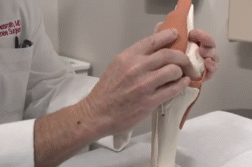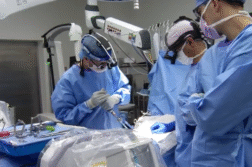Tim Wang, MD, Orthopedic Surgeon at Scripps Clinic in San Diego, CA talks about fixing complex knee surgeries.
Interview conducted by Ivanhoe Broadcast News in 2024.
So let’s talk about complex knee injuries. In your practice, how common are knee problems?
Wang: I’d say knee problems and athletic knee problems, complex knee problems are a good portion of my practice and something that I’ve had both a professional and personal interest in, treating as well as on the research end as well.
So there’s probably a lot of causes. Is it mostly extreme athletes or is it your weekend warrior or what?
Wang: Knee injuries we see in all different types and reasons. Most commonly, there are sports injuries, soccer, football, basketball. And those can lead to injuries such as ACL tears, and meniscus tears. Though also we can see them in all people, just from unfortunate accidents as well.
So with Tatum, how did she present to you?
Wang: So Tatum came to us after she’d already had a few surgeries and had seen a few orthopedic surgeons. Her initial injury was an ACL tear that she had while playing volleyball. And unfortunately, this in combination with other injuries, had led her down a path of multiple and complex other associated injuries to the meniscus cartilage and ligaments of the knee.
And she had been through a lot, she has done a lot to try to repair. She was living with pain for quite a while, right?
Wang: She’d been through a lot and unfortunately, she’s the typical patient. These are often young, active women in particular with ACL injuries that have sustained some sort of damage early on. And for whatever reason, due to the nature of the injury, have been unable to get back to sports, exercise or activity.
What were you able to offer her that she hadn’t had before?
Wang: So, we’ve come a long way in terms of our approach from a medical standpoint of how we evaluate these injuries. And she certainly had a complex issue where it was not just one problem, but multiple problems altogether. Historically, our orthopedic community would look at each of these problems individually, cartilage problem, meniscus problem, ligament problem. But we’ve learned that these injuries don’t occur in isolation, but they all work together. They support each other, they help each other out for stability, cushioning, and health. And being able for us to take a step back and look at everything from a big picture perspective with regards to what her knee injury was, who she was, and what goals exercise, sports she wanted to get back to is very important for us.
Were you able to do two procedures?
Wang: So, with these injuries that have had previous surgeries, we often times break these up into two parts. The first is more of like a diagnostic, looking in the engine of the car, trying to figure out exactly what the damage is, get a list of what exactly is broken and torn. And that helps us to formulate a good game plan for the next stage, which is really the restorative procedure to “fix the problem.”
What was that restorative problem-restorative procedure?
Wang: So again, Tatum has had a lot of complex issues, including two or three prior ACL surgeries, meniscus that was essentially absent, and some permanent damage to her articular cartilage or the smooth cartilage on her knee. Historically speaking, we had very little to no solutions for both the meniscus problem as well as the cartilage problem. But thankfully, here at Scripps Clinic, we’re at the leading forefront of technology for both treatment for cartilage and meniscus injuries. And we were able to treat all of those together, with a revision ACL or a redo ACL reconstruction. A meniscus transplant for her, so a cadaver meniscus that we’ve placed in here. As well as a living cartilage transplant to her femur bone.
Can you be a little bit specific about how that works?
Wang: So all of our bones have a lining of articular cartilage, that’s the smooth gliding surface on the end of the knee, thinking like the tread on the tire. That can get damaged either through wear and tear over time or after an injury. The problem is once these cartilage injuries occur, they don’t grow back on their own. And again, historically speaking, we didn’t have a solution for these. At Scripps Clinic, we are the worldwide expert and have the most experience in the treatment of these cartilage injuries and cartilage transplant, with our cartilage program pioneered by Doctor Bill Bugby here. But what that really means is removing the section of unhealthy cartilage and bone in the femur and replacing with a living cartilage and bone from a healthy donor.
So explain how that works, if you get a healthy donor for cartilage, how do you get that?
Wang: So it’s almost like patching a piece of dry wall and that we can drill out or remount a coin shaped hole in where the problem is and create a matching coin from a donor. So we do get a donor femur bone cartilage segment and fashion it to fit, so that it matches perfectly in both depth as well as contour of the bone. The benefit is that it’s immediately stable right away too.
Will this last a lifetime?
Wang: So with these, the goal is not necessarily to turn the knee back to normal. As much as we wish, with these complex knee injuries, it’s tough for us to get the knee 100 percent back to normal. The goal is to give them 10, 15, 20 years where they have pain relief, ability to return to their sports exercise and activity, as well as push off the need for any more invasive surgery such as a knee replacement.
Is there a person who’s a better candidate for this than others?
Wang: People that are good candidates for this are typically young, active patients less than the age of 40 or 50 with injuries to the articular cartilage or meniscus, that have tried other treatment methods such as physiotherapy or injections, but still have pain, discomfort, and inability to get back to their desired level of sport, exercise and activity.
So is this the pinnacle of this type of surgery right now, is this is as good as it gets?
Wang: The exciting thing for us as an orthopedic community is this really is the forefront of where we are in terms of cartilage treatment. Again, historically speaking, our treatments were very limited. And the typical approach was, I’m sorry you have this injury, you have to live with it. And then in ten years or 20 years, just go get your knee replaced. We now have some options such as this cartilage transplant that can allow us to have early intervention and almost prevention to try to hold off the disease from getting so far advanced, where patients may need a knee replacement. And be able to treat problems which we previously didn’t have any solutions for.
When you’re working with these patients, they’re just like Tatum, and now you’re getting Tatum back out on the volleyball court, that has to be a pretty good feeling, right?
Wang: I think that’s the most rewarding part of our job. And what we can offer here is that we can take somebody with a devastating knee injury where they may be unable to go to the grocery store, unable to walk, play with their kids, or be involved in their sports that they’ve really liked since they were, a teenager and be able to certainly with a lot of work, both from a surgical standpoint, rehabilitation, but get their knee to a point where they can get out and do the things they want and not be held back by their knee. In terms of their day to day life, their recreational functions, as well as their other demands they have on their life.
END OF INTERVIEW
This information is intended for additional research purposes only. It is not to be used as a prescription or advice from Ivanhoe Broadcast News, Inc. or any medical professional interviewed. Ivanhoe Broadcast News, Inc. assumes no responsibility for the depth or accuracy of physician statements. Procedures or medicines apply to different people and medical factors; always consult your physician on medical matters.
If you would like more information, please contact:
Stephen Carpowich
Carpowich.stephen@scrippshealth.org
Sign up for a free weekly e-mail on Medical Breakthroughs called First to Know by clicking here




